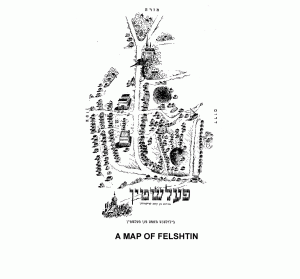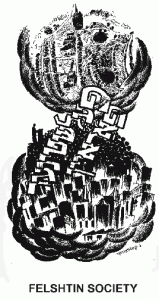By Professor David G. Roskies
The following is an excerpt from The Jewish Search for a Usable Past by Professsor Roskies, 1999, reprinted with the permission of Indiana University Press.
During World War I and the Ukrainian Civil War [Eastern European Jewish immigrants] were forced to stand by and watch as the heartland was destroyed. “When the shocking news of the Pogrom reached us here,” writes a spokesman for the First Felshteener Benevolent Association, “we, and especially our women, were prostrated with grief. The sudden realization that we had lost so many of out relatives, so abruptly by such a cruel death, that never again would we see them — mother, father, sister, brother — filled us with great distress.”


There is no more graphic illustration of Morawska’s thesis than Felshtin: Anthology in Memory of the Felshtiner Martyrs (1937), one of the first memorial volumes to a lost shtetl produced on North American soil. Felshtin and Proskurov led the way because their Jewish communities were among the first to be destroyed — during the Ukrainian Civil War (see fig.1). This proves, if further proof is needed, that in modern times, the dynamic of inner- Jewish renewal is always predicated on the awareness of loss. Tile moment the past is finally laid to rest is the very moment that it reasserts its claim upon the living.
Easier said than done. So great was the divide between the Old World and the New that the task of memorial demanded such means as were still beyond those of the vicarious survivors. Year in, year out, the members of the First Felshteener Benevolent Association gathered on New York’s Lower East Side to commemorate the martyrs. This spontaneous gesture grew directly out of the received norms of group behavior. Assembling a memorial book was something else again.
For starters, the concept of a map was utterly foreign to the shtetl’s conceptual universe. Mendele the Book Peddler had already known this, trapped as he was within a make-believe world of satiric place names. And so the Felshtiner commissioned a “bird’s-eye view” of their beloved town from the popular illustrator of Yiddish children’s books, Notte Kozlovsky (fig 2). The sun is always shining on this quaint little town, flanked oil its south side by a millstream, on the west by an onion-domed Eastern Orthodox church, and in the east by a huge Catholic church, whose spire cash a long shadow.

When it came time to document the history of its town and its most prominent sites, however, the editorial board came up short. There was no information to be had on the main shul, situated in the heart of the Jewish quarter. None even about the two tallest buildings in town that towered over the marketplace and were now owned by Jews — or had been, until the pogrom.
The profusely apologetic editor of the memorial book and its chief contributor, Jonah Baum, documented his futile efforts to glean archival material from elderly Jews who still remained in Felshtin, from the young professional archivist Ezekiel Lifschutz, and from the YIVO Institute in Vilna. As if to compensate, Kozlovsky was asked to illustrate a number of dramatic and sentimental memoirs (which gives the volume an unintentionally juvenile appearance, for all its massive size) and to provide two more versions of the shtetl entire: one a ghoulish image of Felshtin in the shape of a skull (fig. 3), and another that depicts the town — churches and all — descending like a cloud until it comes to rest within the Manhattan skyline (fig. 4). The message could not be clearer. Taken together, the maps lay out the narrative history of the shtetl according to a familiar, archetypal pattern: from obscure birth, to full flowering, to suffering and mass martyrdom, to rebirth in the Promised Land.
The Felshtin memorial book was the second of many. For the most profound break was still to come. In the shtetl’s last chapter, the surviving sons and daughters of the European catastrophe became the scribes of a new, collective scripture. Together, in the face of their common loss, they found a form of recovery commensurate with the loss.
At long last, the Jews of the shtetl assumed full responsibility for recording its history. They did so piecemeal, town by town, with little professional help, and from the geographical remove of North and South America, Israel, and France. There are by now some twelve hundred such yizkor books, and they have become the memory bank of East European Jewry. This grassroots phenomenon is unique. Although the yizkor books await their own historian, it is possible to draw some tentative conclusions.
- The yizkor books represent a valiant group effort to shape the disparate and conflicting memories of former shtetl inhabitants and the pieces of the symbolic shtetl landscape into a lasting, coherent, memorial.
- The primary function of these communal histories is to work through the collective trauma of the Holocaust. The crowded pages of yizkor books are therefore dedicated to the memory of the Jewish life that was destroyed.
- After a brief chapter that outlines what little is known about Jewish life in the town prior to the twentieth century, the yizkor book hits its stride with vignettes about the coexistence of tradition and modernity on the crowded shtetl streets: rabbis, scholars, philanthropists, merchants, and madmen, rubbing shoulders with political activists, youth groups, amateur actors, soccer players, cyclists, modern women, and local boys who made good.
- Within that idealized group portrait, there is an occasional Polish nobleman to liven things up. Otherwise, the Gentiles are depicted as an undifferentiated mass of peasants who appear and disappear on market day. Jewish-gentile relations are recalled in the context of strikes, pogroms, anti-Jewish boycotts, murders, and the Holocaust.
- Every yizkor book includes detailed eyewitness accounts of the beatings, hangings, shootings, ghettoization, and total annihilation of the Jews. They name names. They are almost too harrowing to read.

In more ways than one, these memorial books are a species of fiction. They borrow unconsciously from literary sources, even as they interpolate bona fide works of prose, poetry, and professional memoir. The landslayt are justifiably proud of their native sons and daughters who became published authors, and they comb through their writings for suitable material. In this way, paradoxically, a literature that tried to emancipate itself from the shtetl was reabsorbed back into it.
The evolution of the shtetl into a covenantal landscape reaches its logical conclusion in the yizkor books. The literary image of the shtetl, as we have seen, was deliberately fashioned from the very outset to incorporate the shtetl’s demise into its physical landscape, its mythic structure, and its ideological message. The writers — who were the prophets and rabbis of the Jewish immigrant masses — had been pronouncing the shtetl’s last rites for a hundred years. The immigrant experience now confirmed from below what the writers had been pronouncing from above at least since the days of Sholem Aleichem and Peretz: The shtetl is dead. Long live the shtetl!
The memorial books, by never allocating more than a third of their space to documenting the destruction of the town at the hands of the Germans and their willing collaborators, make each volume into a testament of life-in-death.
As tradition and modernity once rubbed shoulders on the shtetl streets, so are grainy images of the lost home juxtaposed with photos of well-dressed shtetl sons and daughters in their far-flung promised lands. Whenever and wherever they reconvene for a group photo, they reassert the final, stirring words of the Partisans’ Hymn: “Mir zaynen do, we are herel”
David G. Roskies is a Professor of Jewish Literature at the Jewish Theological Seminary of America, co-editor of Prooftexts: A Journal of Jewish Literary History, and has he authored several books, including The Shtetl Book, Against the Apocalypse, and The Literature of Destruction.